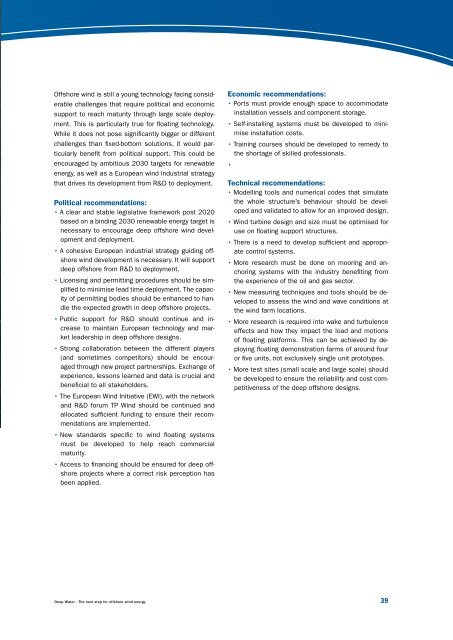Deep_Water
Deep_Water
Deep_Water
Create successful ePaper yourself
Turn your PDF publications into a flip-book with our unique Google optimized e-Paper software.
Offshore wind is still a young technology facing considerable<br />
challenges that require political and economic<br />
support to reach maturity through large scale deployment.<br />
This is particularly true for floating technology.<br />
While it does not pose significantly bigger or different<br />
challenges than fixed-bottom solutions, it would particularly<br />
benefit from political support. This could be<br />
encouraged by ambitious 2030 targets for renewable<br />
energy, as well as a European wind industrial strategy<br />
that drives its development from R&D to deployment.<br />
Political recommendations:<br />
• A clear and stable legislative framework post 2020<br />
based on a binding 2030 renewable energy target is<br />
necessary to encourage deep offshore wind development<br />
and deployment.<br />
• A cohesive European industrial strategy guiding offshore<br />
wind development is necessary. It will support<br />
deep offshore from R&D to deployment.<br />
• Licensing and permitting procedures should be simplified<br />
to minimise lead time deployment. The capacity<br />
of permitting bodies should be enhanced to handle<br />
the expected growth in deep offshore projects.<br />
• Public support for R&D should continue and increase<br />
to maintain European technology and market<br />
leadership in deep offshore designs.<br />
• Strong collaboration between the different players<br />
(and sometimes competitors) should be encouraged<br />
through new project partnerships. Exchange of<br />
experience, lessons learned and data is crucial and<br />
beneficial to all stakeholders.<br />
• The European Wind Initiative (EWI), with the network<br />
and R&D forum TP Wind should be continued and<br />
allocated sufficient funding to ensure their recommendations<br />
are implemented.<br />
• New standards specific to wind floating systems<br />
must be developed to help reach commercial<br />
maturity.<br />
• Access to financing should be ensured for deep offshore<br />
projects where a correct risk perception has<br />
been applied.<br />
Economic recommendations:<br />
• Ports must provide enough space to accommodate<br />
installation vessels and component storage.<br />
• Self-installing systems must be developed to minimise<br />
installation costs.<br />
• Training courses should be developed to remedy to<br />
the shortage of skilled professionals.<br />
•<br />
Technical recommendations:<br />
• Modelling tools and numerical codes that simulate<br />
the whole structure’s behaviour should be developed<br />
and validated to allow for an improved design.<br />
• Wind turbine design and size must be optimised for<br />
use on floating support structures.<br />
• There is a need to develop sufficient and appropriate<br />
control systems.<br />
• More research must be done on mooring and anchoring<br />
systems with the industry benefiting from<br />
the experience of the oil and gas sector.<br />
• New measuring techniques and tools should be developed<br />
to assess the wind and wave conditions at<br />
the wind farm locations.<br />
• More research is required into wake and turbulence<br />
effects and how they impact the load and motions<br />
of floating platforms. This can be achieved by deploying<br />
floating demonstration farms of around four<br />
or five units, not exclusively single unit prototypes.<br />
• More test sites (small scale and large scale) should<br />
be developed to ensure the reliability and cost competitiveness<br />
of the deep offshore designs.<br />
<strong>Deep</strong> <strong>Water</strong> - The next step for offshore wind energy 39


